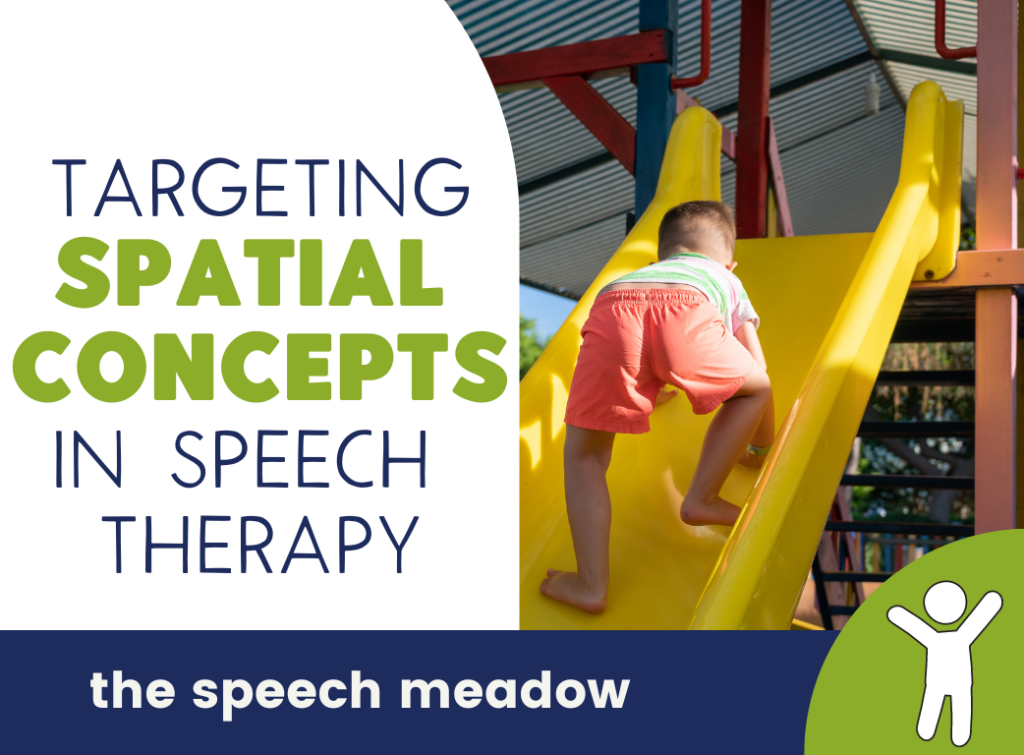Children with language disorders often struggle with understanding and using prepositions. Prepositions are an important group of words. Understanding prepositions (aka spatial concepts) will help children follow directions. Being able to use them will help children answer questions and make longer more sophisticated language. As such we tend to work on targeting those prepositions in speech therapy.

Where to Start?
Children learn prepositions easier when they can physically experience the preposition. For example, standing between two chairs. Children with vision and mobility difficulties tend to struggle more with understanding these concepts. Doing activities where the children go under, beside, next to, between, etc. help children understand where their body is in space. At school, you can talk about where they are lined up. E.g., John you are between Suzy and Jane. Or Go line up behind Frank.
You can play games at the park where you tell the children to go to specific locations. E.g.. Run and stand beside the swings. If you can create an obstacle course and tell them how to go through can also be a fun activity (e.g. go through the tunnel, stand beside the chair). Playing with boxes are also a great activity to teach spatial concepts. Go here for more ideas on how to use boxes to target prepositions in speech therapy..
Preposition Activities
Make a preposition book with the child. Have the child pose for pictures and then make them into a little book where you and the child can read. If the child doesn’t want to be in the pictures, use a favourite toy to take the pictures. Reading books about spatial concepts can also be a great addition to your speech therapy sessions.
When playing with a doll house or a farm set, tell your child where to put different furniture/equipment/animals. E.g., “Put the tractor beside the barn.” When everything is set up and you start playing talk about where your people/animals are going. E.g., “My horse is out of the barn! She is beside the tractor.”
Play Hide and Seek with stuffies. There are a few versions of this game. Take turns hiding the stuffies around the room and the other person/people look for them. When looking, name where you are looking. E.g., “Is the bunny UNDER the table?” “No. It’s not UNDER the table.” You can also do this when people are hiding. Another version is to have one person tell another person where to hide the stuffy.
Like the elf that sometimes come around at Christmas, have a stuffie hiding around the house or classroom where children need to look for and tell you where it is.
Activities for home
Help with putting the groceries away. Tell your child where to put the different food. E.g., “The apples go on the middle shelf in the fridge.”
Help put laundry away. Tell your child which shelf/drawer the clean clothes needs to go.
Have your child help set the table. Tell them where to put the dishes and cutlery. Note! You can use paper or plastic dishes and cutlery to avoid dishes being accidentally broken.
Activities on TpT (Teachers pay Teachers)
Lastly there are many paper or structured activities that you can buy on TpT (teachers pay teachers). Click here to explore what is in my store.
If you would like a parent/teacher friendly handout on how to work on prepositions, click here. Let me know what your favourite activity you do to target prepositions in speech therapy.
